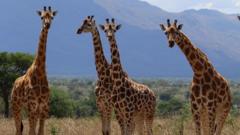The study involved extensive analysis of skull sizes and head shapes to identify significant genetic differences among the giraffes. Furthermore, the researchers examined Africa's diverse landscapes, including rivers and valleys, which likely led to the separation and independent evolution of these towering mammals.
The newly identified species consist of the Southern giraffe, native to regions like Angola and Namibia; the Reticulated giraffe, found in Kenya and Ethiopia; the Northern giraffe, existing in parts of South Sudan and Uganda; and finally, the Masai giraffe, residing primarily in Kenya and Tanzania. Contrary to earlier beliefs, their varied patterns and locations denote them as separate species rather than mere subspecies.
The implications of this discovery are significant for conservation strategies. Michael Brown, the report's co-author, emphasizes that understanding these genetic distinctions is essential for effective conservation. The IUCN plans to reassess the vulnerability of these four newly recognized species, advocating for more robust protections to ensure their survival in the wild.
The unveiling of these species reaffirms the need for urgent conservation efforts in the face of habitat loss and other threats, painting a hopeful picture for the future of these iconic animals.
As we deepen our knowledge of giraffe taxonomy, we pave the way for more effective strategies to safeguard their populations and ensure that these gentle giants continue to roam the African plains.
The newly identified species consist of the Southern giraffe, native to regions like Angola and Namibia; the Reticulated giraffe, found in Kenya and Ethiopia; the Northern giraffe, existing in parts of South Sudan and Uganda; and finally, the Masai giraffe, residing primarily in Kenya and Tanzania. Contrary to earlier beliefs, their varied patterns and locations denote them as separate species rather than mere subspecies.
The implications of this discovery are significant for conservation strategies. Michael Brown, the report's co-author, emphasizes that understanding these genetic distinctions is essential for effective conservation. The IUCN plans to reassess the vulnerability of these four newly recognized species, advocating for more robust protections to ensure their survival in the wild.
The unveiling of these species reaffirms the need for urgent conservation efforts in the face of habitat loss and other threats, painting a hopeful picture for the future of these iconic animals.
As we deepen our knowledge of giraffe taxonomy, we pave the way for more effective strategies to safeguard their populations and ensure that these gentle giants continue to roam the African plains.























